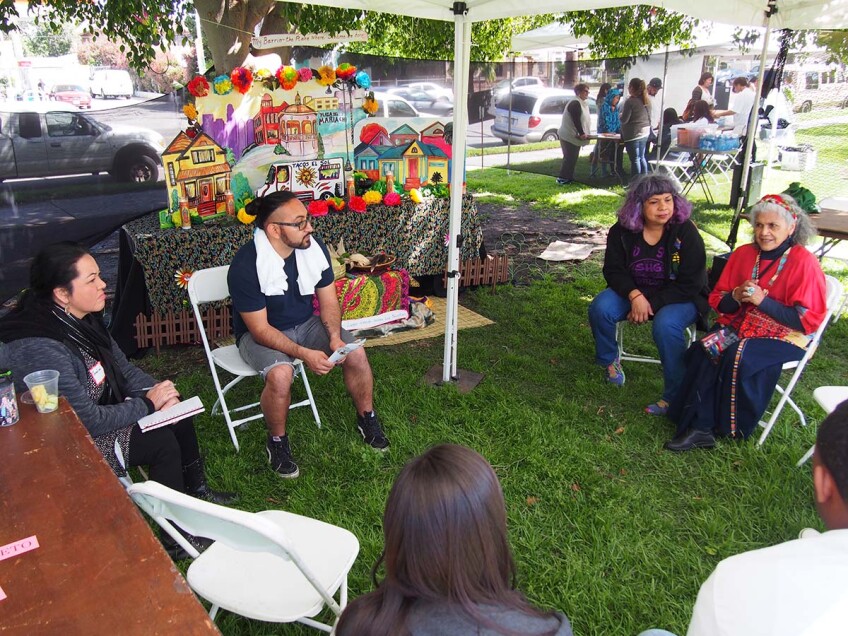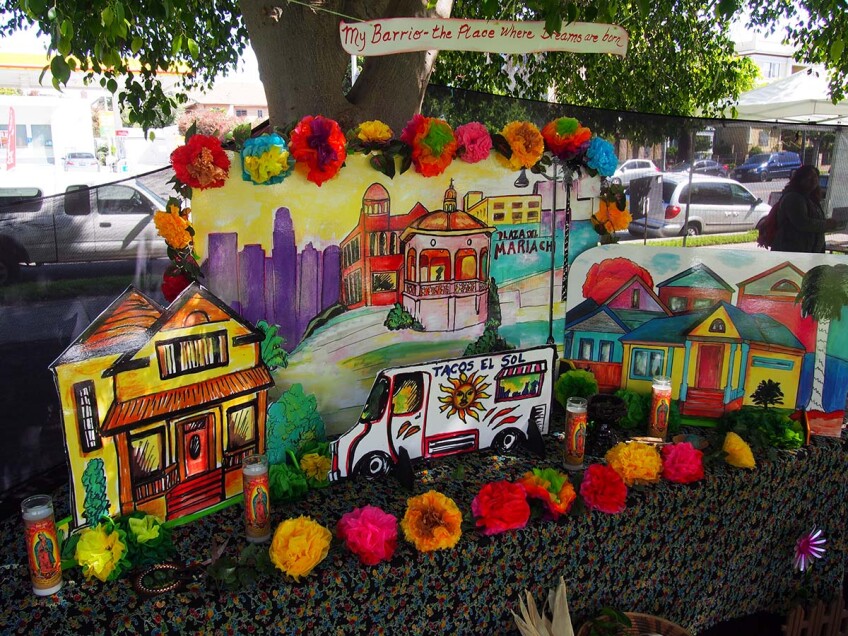Ofelia Esparza Brings Altar-Making Beyond Dia de los Muertos

Commemorating a loved one who has passed is a bittersweet experience: in it, we find a way to remember the way they made us laugh, the things they loved most, the character traits that made them one of our favorite people. We remember, then, that we can’t see them anymore.
The altar, or ofrenda, functions within the context of Día de Los Muertos as a way to remember and honor loved ones who have passed away in a beautiful, visual way. They can involve flowers, candles, photographs of loved ones, food items and more. They become visual reminders of a person, a promise to keep them in our memories even as the years pass.
Los Angeles artist Ofelia Esparza’s work expands the commemorative and cultural power of the altar beyond that one day of the year, and over the decades, she has made an indelible mark on the art world and Los Angeles’ cultural traditions.
Esparza has also taken the tradition of altar-making beyond the confines of Día de Los Muertos by working with the Alliance for California Traditional Arts (ACTA), a nonprofit organization that focuses on traditional and folk arts, especially those tied to California.

“When we think about what Ofelia means to East L.A., it’s pretty amazing,” says Quetzal Flores, Program Manager for the Building Healthy Communities in Boyle Heights. Building Healthy Communities in Boyle Heights is a collaboration between ACTA and the California Endowment, which looks at how “heritage-based arts practices can contribute to community empowerment, comprehensive neighborhood revitalization and better health outcomes.” “She, for generations, held the information, the practice of the altar and was generous enough and accountable enough to impart it.”
Ofelia’s work is intertwined with the history of the long-running East L.A. art institution, Self Help Graphics & Art, in many ways. When it comes to Día de Los Muertos celebrations in Los Angeles, SHG plays a large role in fostering new traditions. In the early seventies, the organization started organizing a parade and the celebration spilled out onto the streets. Now running for more than 45 years, the celebration attracts more than 10,000 people every year. In 2007, the organization moved to Boyle Heights.
The tradition grew quickly because of SHG and also the artists involved. In 2017, Esparza told “Artbound,” about the yearly event: “It bridges generations, especially here in Los Angeles, not only generations but countries. Now it [also bridges] cultures because it’s been open to the whole nation, the whole world.” Throughout this time of growth in the Día de Los Muertos tradition, Esparza has been present, teaching generation after generation the intricacies of altar making and the reasons for this sacred tradition.
As part of ACTA’s Arts in Corrections program, Esparza and her daughter Rosanna Esparza Ahrens also began teaching a Poetry and Assemblage class at a women’s prison in Chino.
When she arrived in Chino with her mom, Esparza Ahrens expected to encounter a stereotypical image of a prison. She was surprised to see that the space has “grass and trees.” The duo leads the group in creating both art and poetry; as the weeks have gone by, Esparza says it’s clear that the students “are hungry for this kind of opportunity of free expression.”
At the beginning of the program, the two organized “an arriving ceremony.” After breathing exercises and cleansing with sage — not lit indoors, but passed around for students to inhale and “take in the aroma,” says Esparza Ahrens — students were asked to say their name “in their heart” and then again out loud.
They say it to themselves one more time, focusing on what the voice sounds like. Perhaps it’s the voice of a loved one or a friend; either way, it allows the students to ground themselves and go to a “place where they know they are loved,” says Esparza Ahrens. This process helps to “ground them,” Esparza Ahrens says, so that they can enter into their writing and artmaking knowing that the space is a safe and positive one. The work they produce becomes a way to assert their identity and the value of their expression, even while they might currently not be able to engage in other parts of society.
“These works of art are reminders of where they’ve been and hopefully a positive note in the life that they could just take with them wherever they go even if they're confined to a certain place where they are,” Esparza says.

Esparza and her daughter have also worked with the Building Healthy Communities Initiative, which looks at “arts & cultural assets as central resources essential to health and sustainability,” according to its website. The program focuses on four different communities, including Boyle Heights. The two are part of the “prevention group” of the program, as part of the group’s “working on policy.” At most meetings, you can find community organizers, residents and people working within legal aid. The duo noticed that many members, at first, just wanted to get the meeting over with and move on with their days. The group agreed to give Esparza Ahrens and Esparza fifteen minutes at the beginning of each meeting for what they initially called an “icebreaker,” but the two emphasized the process as one of “meditation” and “connecting.”
“There is an agreement with the chair that we are planning — we're part of the planning, of the agenda,” Rosanna says. “Not necessarily what’s going to be on the agenda but how we're going to deliver it, and how we're going to open up and connect around the main points of the agenda.”
The duo sees the ofrenda as a guiding symbol for the way that meetings with Building Healthy Committees function, even while they might not be building them. They want to make sure that all voices, not just a privileged few, get the same attention — similar to how all ofrendas should receive the same respect.
“An altar that you see on the curbside with flowers for someone who has given their last breath there, at this section, or one that's in a home with a flower or a candle and a photograph or these elaborate ones that Rosanna and I do for several years now,” says Esparza. “To me, they all have the same significance, the same sacredness… for the same token, everybody's voice in those meetings… everyone’s voice is valuable to this meeting.”
Esparza and Rosanna’s past altars — which have been shown in museum exhibitions — often used marigolds (a common flower in altars, known for its medicinal properties). The flowers offer bursts of color throughout an altar, often culminating in a tall, sculptural form at the top of the piece. Other elements include a Virgen de Guadalupe statue, candles, lace doilies, photographs of loved ones and plates filled with food.
They do a similar “arriving ceremony” at these meetings to help everyone feel connected and valued.

Juana Mena, who previously took a class with the duo, felt hesitant at first about creating an art project dealing with death. The plan was to create a nicho, a box-like piece that each individual would make. Then, the pieces would be put together to create an altar.
Mena took the workshop while plans for My Health LA,a “program for low-income residents of Los Angeles County who do not have health insurance,” were coming to fruition.
Mena’s piece focused on her fears of “not having [money] for my medicines, not being able to take care of myself, getting sick and not having resources.” The project became a way to “express and communicate many things” related to her health and worries. Her piece — decorated in her favorite colors of yellow, orange and black — included flowers, necklaces and a small box that contained her current medicines wrapped in small chains to symbolize her lack of access to them. She included a photograph of lungs to indicate her health condition. The piece was meant, then, to heal her “interior.”
“I always liked art, and I always saw myself reflected,” says Mena. “But yes, participating in Ofelia’s class helped me to reaffirm what I believed.” Even now, Mena describes Esparza as an inspiration.
The bond between mother and daughter plays an important part in the altar-making and classes. The two “work as a team” and bring their combined life experiences to each meeting and class.
“I don’t think I could do this all by myself because she's grown up with this altar building since she was a teenager,” says Esparza. “As we build our own programs or activities, that concept of the altar that has the layers of foundation of the present and even into the future or beyond, applying it to these different populations and activities… that’s the part that I think is so rewarding”
At the time of this interview, the two were at week five of their thirteen-week Arts in Corrections program. As a final project, they plan to display the students’ work.
“Our vision is to take all those pieces and create an assemblage of their art and their writing so they can see it all in one space,” says Esparza Ahrens. “Like an exhibition of all their work together as a complete piece — that's like their altar.”
Ultimately, they hope to foster a space for further creative exploration and leave the students with “tools for them to use on their own.” Tools that help them reassert their identity, remember their past and make their way into their futures. The altar, then, finds another life and continues to expand in meaning and symbolism.

Top Image: Ofrenda | Image from "Artbound" Día de los Muertos/Day of the Dead







